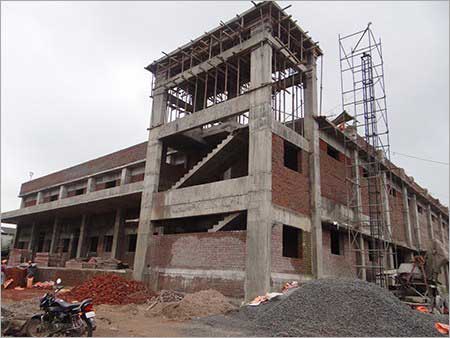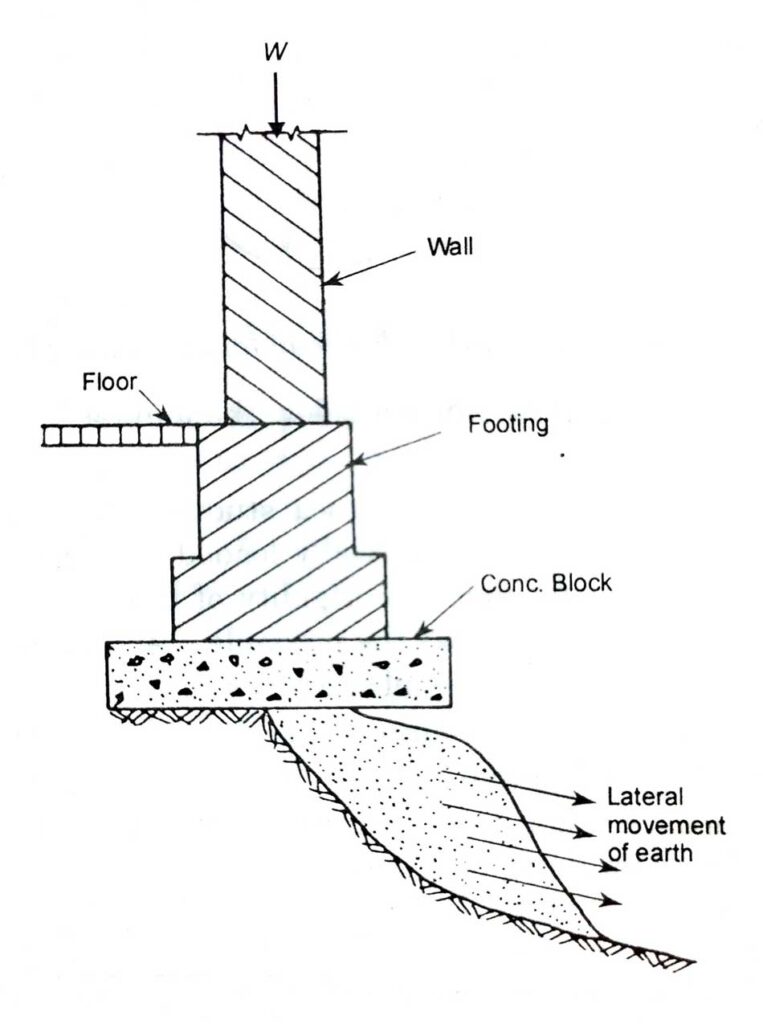Table of Contents
Foundation is the most important part of any structure. We are well known that the load of the structure is transmitted to the under-laying soil via the foundation. Therefore, the special concern should be given by a civil engineer while designing the foundation, so that it should not fail in any circumstances. In this post, I’m going to share some common causes of the failure of the foundation and some remedial measures for such failures.
The main causes of failure of foundation are listed below:
- Unequal settlement of the sub-soil.
- Unequal settlement of the masonry.
- Horizontal movement in adjoining soil.
- Withdrawal of moisture from the sub-soil.
- Lateral pressure on the super-structure.
- Action of atmospheric agencies.
- Lateral escape of the soil from below the foundation.
Unequal Settlement of the Sub-soil
Causes
Following may be the causes of unequal settlement of the sub-soil:
- Nature of soil not being uniform throughout the foundation.
- Load on all the parts of the foundation is not uniform. This is mostly the case because different parts of the building may be different in height.
- Eccentricity of the load.

Unequal settlement of the soil causes the development of cracks in the superstructure, which may ultimately lead to its collapse.
Remedies
Following are some of the remedial measures which can be adopted to safeguard the structure against this defect:
- Foundation should be made to rest on hard base of rock or hard moorum.
- Safe bearing capacity of the sub-soil should not be allowed to be exceeded even under worst possible conditions.
- Loading on foundation should be maintained axial. If there is some eccentricity it should be less than b/6 of the wall, where 6 is the width of foundation. Intensity of maximum pressure should remain less than the safe bearing capacity of the sub-soil.
Unequal Settlement of the Masonry
Causes
The mortar used in masonry shrinks with time. If the structure is loaded excessively before the mortar has fully set, it may cause differential settlement of the masonry, causing failure of foundation.

Remedies
The following measures may be adopted to prevent it:
- Mortar of correct workability she aid be used in masonry work. Too lean or too stiff mortar is harmful.
- Masonry work should be raised uniformly.
- The height of masonry raised in lime mortar per day should not be more than 1 m. In case cement mortar is used, per day height of masonry may be restricted to 1.5 m.
- Masonry work should be properly cured for at least 10 days in case cement mortar is used and for 7 days if lime mortar is used in the masonry work.
Horizontal Movement in Adjoining Soil
Causes
This difficulty is noticed commonly in clayey and black cotton soil regions. These soils undergo considerable volumetric change when subjected to moisture changes. Alternate shrinkage and swell of the soil forms cracks in the soil. If proper measures are not taken during construction, these cracks may affect the foundation and cause differential settlement in the structure. And, this finally leads to the failure of foundation.

Remedies
To eliminate the effects of movements in the soil, following precautions are suggested to be adopted:
- Restrict the loading intensity on foundation soil to 5.5 t/m2. If water is likely to find access to the foundation, the intensity of pressure on foundation soil should be restricted to 4.9 t/m2 to avoid the failure of foundation.
- Depth of foundation should be such that cracks may not reach it.
- Prevent direct contact of foundation with bottom and adjoining soil by enclosing the foundation in a blanket of sand.
- It is preferable if raft or pile foundations are adopted instead of conventional foundations.
Moisture Withdrawal from the Sub-soil
Causes
If somehow moisture from the soil underlying the foundation is withdrawn below a certain limit of moisture content, the soil particles lose cohesion and shrinkage is caused. This shrinkage of soil can cause cracking of the structures. This the failure of foundation may occur. Withdrawal of moisture from subsoil may occur due to the following reasons:
- Transpiration of trees or shrubs near the foundation.
- Structures are founded on damp soil overlying a layer of sand, gravel or some other porous material.
- Variation in water table being considerable.
- Abnormally dry weather prevails.
Remedies
Following precautions may be taken to prevent such failure of foundation:
- Trees should be planted at a safe distance from the foundation. The safe distance may be considered as 1.5 times the height of the matured tree.
- The foundation should be carried deeper. At no place the depth of the foundation should be less than 0.9 m.
- Pile or raft foundation may be used.
Lateral Pressure on the Superstructure
Causes
The horizontal thrust of a pitched roof or arch action or violent storms tend superstructure walls to tilt or overturn, causing failure of foundation. A cantilever projection from a wall also causes the tilting tendency in the wall.

Remedies
Remedial measures to prevent this failure is to provide a sufficiently wide base to the foundation and to design the foundation for the worst possible conditions.
Action of Atmospheric Agencies
Causes
During heavy rains, water may collect near foundation and during its passage downwards may carry certain salts from sewage, animal dung or even from soil it is passing through. Such salts may react chemically with foundation materials and may cause their disintegration. Also if foundation is not deep enough, rain water flowing away may carry the soil along with it and may expose the foundation.
Remedies
The following remedial measures may be adopted to avoid such failures:
- Depth of the foundation should be sufficiently deep so that rain water may not reach it. ‘
- To maintain the water table at a definite level proper underground drainage system should be installed.
- If possible, stone masonry should be used in foundation. Stone is less affected by atmospheric agencies.
- After masonry work is completed, the sides of trenches should be carefully back-filled and consolidated. The ground adjoining the walls should be given gentle slope to enable rain water flow away from the wall. It is preferable if 0.6 m to 0.9 m wide plinth protection is built around the building. Plinth protection is nothing but pucca floor, made at ground level outside the foundation and sloping away from the wall.
Lateral Escape of the Soil below the Foundation
Causes
This failure of the structure is likely if its formation is situated near the river bank or deep cuttings. In this case, if the foundation is not provided with suitable safeguards, the sou from below the foundation may escape or slip sideways, and the structure may collapse.

Remedies
Under such locations, the foundation should be protected by confining sou below the foundation by sheet piles, or by constructing retaining walls.
I hope this article will help you to understand the Causes of the Failure of Foundation and Remedial Measures for Such Failures. You may also want to see my other post from my Blog. If I have missed anything here, please let me know about that in the comment below this post.
Share it with your friends.
Happy Learning.
If you liked this article, then please help me to share this article with your friends through Facebook, Twitter, WhatsApp or Instagram. You can also find us on Facebook, Twitter, Instagram, Telegram Channel, YouTube Channel, and Pinterest. Also, Subscribe to our mailing list to get a new post update from us. And, do me a favour, if you find this post helpful, rate a 5 star below-




